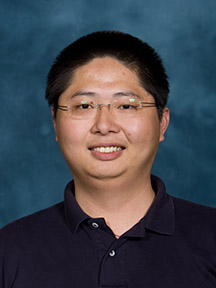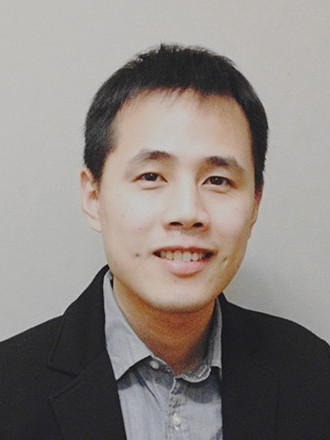Seminars 2012-2013
The Seminar Series begin at 12:30pm unless otherwise specified. Food will be served before the seminars. Financial support for the seminars was kindly provided by the Rackham Graduate School.

|
April 7, 2014
Tools for Quantitative Mechanobiology 12:30-1:30am | Johnson Rooms - Lurie Engineering CenterDr. Beth Pruitt
Associate Professor (Group website)
Department of Mechanical Engineering Quantitative experiments in cellular and organism biomechanics and mechanotransduction demand novel measurement and analysis systems with appropriately tuned mechanical environments and imaging access. We design and fabricate our own tools and systems to address specific measurement needs and are concerned with robust manufacturing and ease of operation for biological research. Biological questions of interest include understanding the sense of touch and hearing, as well as the mechanisms and forces of cell adhesion and tissue development in response to physiological mechanical stimuli. These studies require deformable culture systems designed with appropriate cell-substrate interfaces, cell-cell interactions, and embedded force metrologies compatible with live cell imaging. We deploy deformable cell culture environments and microsystems to apply strain to cells cultured in 2D monolayers or encapsulated in 3D scaffolds. Multi-well and micropatterned devices enable testing multiple conditions such as strain magnitude, biaxial or uniaxial strains in one experiment for high throughput screening of parameters. I will discuss the design and application of quantitative assays to open questions of mechanobiology in cell physiology, stem cells, and biology. |

|
March 24, 2014
Multiplexed microfluidic enzyme assays for detection of metabolic products from living cells 12:30-1:30am | 1180 DuderstadtColleen Dugan
Kennedy Group
Department of Chemistry Microfluidic platforms are powerful analytical tools due to the reduction in reagent consumption, applicability to diverse research areas, and potential for integration of multiple components. The lab-on-chip concept of integrating multiple techniques on one device often allows improved automation and throughput compared to conventional procedures. Adapting chips for applications of cellular research is advantageous, given that the dimensions of the device and the ability to constantly perfuse cell media more closely mimic the in vivo environment. For this study, a novel PDMS chip employing multilayer fabrication techniques has been developed to monitor secretion from cultured adipocytes. Lipid metabolism is heavily controlled by adipocytes, and dysregulation of these mechanisms is implicated in obesity-related disorders like type 2 diabetes. Fatty acids and glycerol are secreted by adipocytes, and their rate of release in relation to one another could provide valuable information for understanding metabolic disease. These analytes can be detected via enzyme assays, which have been modified to create a fluorescent product. The microfluidic device integrates a cell chamber for perfusion of murine 3T3-L1 adipocytes with two reaction channel networks, wherein the cell perfusate can mix with the enzyme reagents for the separate assays. The reaction products of both assays are measured simultaneously on-chip. Through optimization of the reagent flow rates and modification of the PDMS surface, the cellular secretions can be measured within the LDR of the assays. |

|
March 6, 2014
Direct Separation and Analysis of Cells Mediated by Transient Molecular Interactions in Microfluidic Devices 10:00-11:00am | 1670 BeysterDr. Rohit Karnik
Associate Professor (Group website)
Department of Mechanical Engineering Multiple sample-processing steps present a challenge for the development of low-complexity devices for laboratory or point-of-care separation and analysis of cells. In this talk, I will discuss a new approach that can directly separate, enrich, or analyze cells with minimal or no sample processing requirements. We show that transient cell-surface adhesive molecular interactions can exert forces on the cells that can direct the trajectories of cells flowing through microfluidic devices. Such interactions occur in cell rolling, a physiological phenomenon involved in cell trafficking where transient molecular bonds are continuously formed and broken as the cell rolls on a surface under the action of hydrodynamic forces. Using this approach, we demonstrate separation of cells with high purity and efficiency in parallel microchannel devices, and direct separation of neutrophils from blood with ultrahigh enrichment in a neutrophil activation-dependent manner. We extend this approach to controllably contact mesenchymal stem cells with receptor-coated surfaces to quantify cell adhesion behavior by visualization of their trajectories in a “cell adhesion cytometer”, which can track changes in the cell phenotype. The results demonstrate the potential of the emerging technology of using transient cell-surface molecular interactions to directly separate and analyze cells for point-of-care diagnostics, isolation of rare cells, quality control of stem cells, and other applications. |

|
March 6, 2014
Lessons Learnt From Commercialization of Microfluidic Devices 11:00am-12:00pm | 1670 BeysterDr. Kalyan Handique (Bio)
CEO, DeNovo Sciences LLC This talk will go through the entrepreneurial journey of HandyLab, a University of Michigan molecular diagnostics start-up, from its inception in 2000 to its eventual sale to Becton Dickinson in 2009. The talk will focus on the experience of developing and commercializing HandyLab’s microfluidics technology, securing funding from various sources including venture capital, building a world-class team, developing and selling a molecular diagnostic product platform in a regulated medical market, and eventual exiting through the sale of HandyLab to BD for $275MM. Key lessons learnt related to the commercialization of the microfluidic technology as well as building the Company will be discussed. Dr. Handique will also touch upon how he applied some of the lessons learnt earlier to the new cancer diagnostics start-up called DeNovo Sciences. |

|
February 18, 2014
Microengineered Biomaterials and Biosystems for Translational Medicine 12:30-1:30pm | 1180 DuderstadtWeiqiang Chen
PhD Candidate
Department of Mechanical Engineering Many exciting topics exist at the interface between biology and micro/nanotechnology. Taking advantages of state-of-art nanotechnologies and fabricating fascinating functional biomaterials and integrated biosystems, we can address numerous important problems in fundamental biology as well as clinical applications in disease diagnosis and treatment. This seminar will discuss interdisciplinary researches that leveraging the engineering advances in biomaterials, microfluidics and advanced manufacturing for new and better solutions for emerging problems in cancer biology, systems immunology, and stem cell-based regenerative medicine. These novel micro/nanoengineered functional biomaterials and biosystems will not only permit advances in engineering but also greatly contribute to improving human health. |

|
February 10, 2014
Lab-on-a-Chip Technologies Enabled by Acousto-Opto-Fluidics 12:30-1:30pm | 1014 DowDr. Tony Jun Huang
Professor (Group website)
Department of Engineering Science and Mechanics The past decade has witnessed an explosion in microfluidic research and its applications in biology, chemistry, and medicine. This rapid development has occurred mainly because of the continuous fusion of new physics into microfluidic domains. In recent years, researchers have made significant progress in joining acoustic and optical technologies with microfluidics. Optofluidics, the merger between optics and microfluidics, enables the creation of reconfigurable optical components that are otherwise difficult to implement with solid-state technology. Acoustofluidics, on the other hand, offers noninvasive solutions for many on-chip biomedical applications. In this talk, I will present several lab-on-a-chip innovations enabled by acoustofluidics and optofluidics, including acoustic tweezers, tunable optofluidic and plasmofluidic lenses, and miniature fluorescence-activated cell sorters (FACS). These technological innovations have many advantages and are packaged in simple, elegant designs. For example, our acoustic tweezers operate at ~107 times lower power intensity than current optical tweezers. The low power intensity renders our technology noninvasive toward biological samples, as confirmed by experimental results. Moreover, the acoustic tweezers are amenable to miniaturization and versatile—they can be applied to virtually any type of cells or microparticles regardless of size, shape, or electrical/magnetic/optical properties. With the advantages in versatility, miniaturization, power consumption, and technical simplicity, our acoustic tweezers technique are expected to become a powerful tool in many applications, including tissue engineering, microarrays, stem cell biology, and drug screening/discovery. |

|
January 27, 2014
Integrated opto-microfluidic platforms for in situ cellular functional immunophenotyping 12:30-1:30pm | 1180 DuderstadtDr. Pengyu Chen
Post-doctoral Research Fellow
Department of Mechanical Engineering Rapid, quantitative detection of cell-secreted biomarker proteins with a low sample volume is highly critical to advance cellular immunophenotyping techniques for personalized diagnosis and treatment of infectious diseases. Optofluidics, synergistic integration of optical components with microfluidic devices, shows great promise to enable such phenotypic measurements with high precision, sensitivity, specificity and simplicity. Here we developed two opto-microfluidic sensing platforms, namely MIPA and LSPR nanobiosensor, which permit trapping and stimulation of immune cells from clinical samples in a microfluidic chamber with optical access for subsequent cytokine detection. Our strategy of monitoring immune cell functions in situ using opto-microfluidic platforms achieved high-sensitivity with much less sample volume and shorter assay time than that of a conventional enzyme-linked immunosorbent assay (ELISA). This offers great potential for future medical treatments of acute infectious diseases and immune disorders by enabling a rapid, sample-efficient cellular immunophenotyping analysis. |

|
January 13, 2014
The promise of microchannel artificial lungs 12:30-1:30pm | 1180 DuderstadtDr. Joseph A. Potkay Research Investigator Department of Veterans Affairs Lung disease affects over 200 million people worldwide and kills over 2 million people annually. In the United States, it is the only major disease with an increasing death rate. Artificial lung technologies have recently been used to provide respiratory support for lung-disease patients. However, treatment and outcomes with current artificial lung systems remain less than optimal due to limitations in portability, biocompatibility, and gas exchange. Microchannel artificial lungs, on the other hand, promise to enable a new class of truly portable artificial lungs through feature sizes and blood channel designs that closely mimic those found in their natural counterpart. Here, we describe recent efforts to harness advantages at the microscale to achieve artificial lungs with increased gas exchange efficiency, improved portability, and enhanced biocompatibility. |

|
December 9, 2013
Sub-second electrophoretic separations from droplet samples for screening of protein kinase A modulators 12:30-1:30pm | 1690 BeysterErik Guetschow Graduate Student Department of Chemistry University of Michigan Multiwell plate-based high-throughput screening (HTS) has emerged as a powerful tool for drug discovery and evaluation by allowing tens of thousands of assays to completed in one day. Most commonly, assays are performed in multiwell plates with robotic liquid handling and plate manipulation and detected using fluorescence. While this has proven to be a powerful method, several limitations exist, such as single analyte detection and interference from buffer components. To overcome these challenges, we have developed a method to interface droplet microfluidics to microchip electrophoresis (MCE) to screen modulators of protein kinase A using a fluorescently labeled substrate. Samples from screening reactions are reformatted from a multiwell plate into a series of droplet segmented by an immiscible, oil carrier phase. These droplets are then pumped into a PDMS-glass hybrid microfluidic device for analysis by MCE. In the PDMS device, the aqueous droplets are extracted from the carrier phase through a fused silica capillary by a combination of favorable surface chemistry and capillary force. After extraction, droplet contents can be sampled by electroosmotic flow and separated by electrophoresis to detect the labeled substrate and product. While the throughput (0.1 Hz) is lower than that of multiwell plate-based HTS, multiple analytes are detected from each sample and each sample droplet is separated multiple times to reduce the likelihood of false positive and negative results. This assay was used to identify two known PKA inhibitors from a set of 96 test compounds and control samples and the assay has a Z-factor of ~0.9. |

|
November 11, 2013
Microscale optical systems and spectroscopic probes 12:30-1:30pm | 1180 DuderstadtFrancis Esmonde-White Post-doctoral Research Fellow Department of Chemistry University of Michigan Optical systems in microfluidics typically use a microscope for measurements within a chip. Advanced methods for coupling or embedding optical systems into microfludics are still at an early stage. Several advanced approaches are reported in the literature, including coupling external microscale optical probes into chips, integrating or fabricating optical systems directly within chips, or using on chip fluidic systems to control light (optofluidics). Microscale optical probes have one advantage, in that they can be designed and fabricated independently from the microfluidic system, simplifying manufacturing and limiting the potential points of failure in fabrication. The primary drawback to microscale optical probes is the fabrication cost, as they are traditionally fabricated by careful alignment and bonding of a sequence of small optical elements into a tube or onto a prepared planar substrate (such as an etched glass base). The SU-8/PDMS soft-lithography method was modified to create molds for casting polymer optical probes directly onto optical fibers. These monolithic polymer microprobes enable complex optical designs to be precisely fabricated into tiny probes or large non-contiguous arrays without rigorous optical micro-assembly steps. Several applications of these probes as modular detection systems will be presented, including for fluorescence detection in microfluidics and capillary electrophoresis, as well as for biomedical Raman spectroscopy. This unique approach to microscale optical probes has the potential to enable inexpensive, disposable, sterilizable probes for a wide variety of applications. |

|
October 28, 2013
Western Blotting using Microchip Electrophoresis Interfaced to a Protein Capture Membrane 12:30-1:30pm | 1180 DuderstadtShi Jin Graduate Student Department of Chemistry University of Michigan Western blotting is a commonly used assay for proteins. It is used to detect the presence and relative concentration of specific proteins in the given sample of tissue homogenate or extract. Despite the wide utility of the method, it is also characterized by long analysis times, manual operation, and lack of established miniaturized counterpart. The use of microfluidics technique substantially increases the separation speed and shows the potential of higher throughput as well as automation. Chip-Westerns with sensitive semi-quantitative detection and about 30 min per assay time were demonstrated before. Briefly, sodium dodecyl sulfate (SDS)-protein complexes are separated by gel electrophoresis in a chip then transferred to a moving membrane so that they are captured in discrete zones. Detection limits for actin, lysozyme, and carbonic anhydrase are 0.7 nM, 4 nM, and 2 nM respectively. This system is also capable of analyzing complex biological samples. AMP-kinase from cell lysates and lysozyme from egg whites are shown to demonstrate versatility of the method. Advances in throughput have been achieved by multiplexing separations for simultaneous immunoassay. We have made 7 parallel separations each connecting to 3 different samples, making the total 21 assays finish in 31 min. |

|
October 14, 2013
Microfluidics and Cancer: Are We There Yet? 12:30-1:30pm | 1180 DuderstadtSunitha Nagrath Assistant Professor (Group website) Department of Chemical Engineering University of Michigan More than two decades ago, microfluidics began to show its impact in biological research. Since then, the field of microfluidics has evolving rapidly. Cancer is one of the leading causes of death worldwide. Microfluidics holds great promise in cancer diagnosis and also serves as an emerging tool for understanding cancer biology. Microfluidics can be valuable for cancer investigation due to its high sensitivity, high throughput, less material-consumption, low cost, and enhanced spatio-temporal control. The physical laws on microscale offer an advantage enabling the control of physics, biology, chemistry and physiology at cellular level. Furthermore, microfluidic based platforms are portable and can be easily designed for point-of-care diagnostics. Developing and applying the state of the art microfluidic technologies to address the unmet challenges in cancer can expand the horizons of not only fundamental biology but also the management of disease and patient care. Despite the various microfluidic technologies available in the field, few have been tested clinically, which can be attributed to the various challenges existing in bridging the gap between the emerging technology and real world applications. We present here an approach to isolate circulating tumor cells (CTCs) that are shed from the primary tumor into the peripheral blood as an early biomarker of disease. Enumeration of CTCs may have several clinical uses, including determination of prognosis in patients with established malignancy, or even detection of previously undiagnosed cancer. However, due to the limitation of sensitivity and specificity of current technologies for CTC isolation, the full potential of CTCs has yet to be realized. Emerging microfluidic technologies are promising for isolating CTCs with a high yield; however, these platforms often have three-dimensional structures, thus lacking the advantages of traditional planar surface and limiting further characterization and expansion of cells on the chip. Here we present a new approach to more effectively isolate CTCs incorporating the nanomaterial, graphene oxide (GO). |

|
September 30, 2013
Laser Treated Hydrophobic Paper: An Inexpensive Microsystem Platform 1:30-2:30pm | 1017 DowBabak Ziaie Professor (Group website) School of Electrical and Computer Engineering Birck Nanotechnology Center Purdue University Paper as a writing medium has a long and celebrated history dating back to the second century AD (Han court, China) with some earlier Chinese archaeological fragments from the 2nd century BC. In addition to its ubiquitous application as a writing platform, paper in various forms has been used in culinary, art, and crafts. More recently, paper has been investigated as a renewable and inexpensive substrate for microfluidic applications. My laboratory at Purdue University is involved in several projects geared towards using off-the-shelf hydrophobic paper as a microsystem platform through surface modification using CO2 laser. We have developed an array of sensor, actuators, and power sources on parchment, wax, and palette paper with applications geared towards bioflex electronics. In this seminar, I will discuss our efforts in this area starting with a brief discussion of the basic technology followed by several examples such as magnetic actuators, pH and oxygen sensors for wound monitoring, batteries for on-board power source, and catalyst embedded paper for localized oxygen delivery to wound bed. |

|
September 16, 2013
Optofluidic Microscopy and Its Applications in Large Scale Bioscience and Medical Studies 12:30-1:30pm | 1690 BeysterLap Man Lee Post-doctoral Research Fellow Department of Mechanical Engineering University of Michigan Modern compound microscopes use a bulk glass lenses and various optical elements to form magnified images from biological samples. This limits the possibility of shrinking the size of a microscope system. Optofluidic microscopy (OFM) is a miniaturized optical imaging method which utilizes a microfluidic flow to deliver biological samples across a set of sampling points defined in a microfluidic channel for optical scanning. The optical information from these sampling points is collected by a CMOS imaging sensor integrated on the bottom of the microfluidic channel. Although the size of the OFM device is as small as a US dime, it can render sub-cellular resolution images (less than 1 μm) with imaging quality comparable to that of a bulky, standard optical microscope. Optofluidic microscopy has a great potential in high-throughput bioscience or biomedical applications. For example, the integration of OFM systems with high-speed hydrodynamic focusing technology will allow very large scale imaging-based analysis of cells or microorganisms; the compactness and low cost nature of OFM systems enable the development of portable biomedical diagnostic tools for future telemedicine and personalized health care. |
